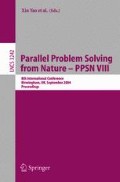Abstract
A scalable architecture to facilitate emergent (self-organized) task decomposition using neural networks and evolutionary algorithms is presented. Various control system architectures are compared for a collective robotics (3 × 3 tiling pattern formation) task where emergent behaviours and effective task -decomposition techniques are necessary to solve the task. We show that bigger, more modular network architectures that exploit emergent task decomposition strategies can evolve faster and outperform comparably smaller non emergent neural networks for this task. Much like biological nervous systems, larger Emergent Task Decomposition Networks appear to evolve faster than comparable smaller networks. Unlike reinforcement learning techniques, only a global fitness function is specified, requiring limited supervision, and self-organized task decomposition is achieved through competition and specialization. The results are derived from computer simulations.
Access this chapter
Tax calculation will be finalised at checkout
Purchases are for personal use only
Preview
Unable to display preview. Download preview PDF.
References
Ballard, D.H.: Cortical Connections and parallel processing. The Behavioural and Brain Sciences 9, 279–284 (1986)
Darwen, P., Yao, X.: Speciation as automatic categorical modularization. IEEE Transactions on Evolutionary Computation 1(2), 101–108 (1997)
Deneubourg, J.-L.: Application de l’ordre par fluctuations ‘a la description de certaines ’etapes de la construction du nid chez les termites. Insectes Sociaux, 117–130 (1977)
Dorigo, M., Colombetti, M.: Robot Shaping: Developing autonomous agents through learning. Artificial Intelligence 71, 321–370 (1994)
Gecshwind, N., Galaburda, A.M.: Cereberal Lateralization: Biological Mechanisms, Associations, and Pathology. MIT Press, Associations (1987)
Gomez, F., Miikkulainen, R.: Solving Non-Markovian Control Tasks with Neuroevolution. In: Proc. of the Int. Joint Conf. on Artificial Intelligence (1999)
Gomez, F., Miikkulainen, R.: Active Guidance for a Finless Rocket using Neuroevolution. In: The Proc. of Genetic and Evolutionary Comp. Conf. (2003)
Jacobs, R., Jordan, M., Barto, A.: Task decomposition through competition in a modular connectionist architecture. Cognitive Science 15, 219–250 (1991)
Kube, R., Zhang, H.: Collective Robotics Intelligence: From Social Insects to robots. In: Proc. Of Simulation of Adaptive Behavior, pp. 460–468 (1992)
Liu, Y., Yao, X., Higuchi, T.: Evolutionary Ensembles with Negative Correlation Learning. IEEE Transactions on Evolutionary Computation 4(4), 380–387 (2000)
Nolfi, S.: Using Emergent modularity to develop control systems for mobile robots. Adaptive Behaviour 5(3), 343–363 (1997)
Nolfi, S., Floreano, D.: Evolutionary Robotics: The Biology, Intelligence, and Technology of Self-Organizing Machines, pp. 13–15. MIT Press, Cambridge (2000)
Stone, P., Veloso, M.: Layered Learning. In: Proc. of 11th European Conf. on Machine Learning, pp. 369–381 (2000)
Thangavelautham, J., Barfoot, T., D’Eleuterio, G.M.T.: Coevolving Communication and Cooperation for Lattice formation Tasks. In: Adv. in ALife: Proc. Of 7th European Conf. on ALife, pp. 857–864 (2003)
Whiteson, S., et al.: Evolving Keep-away Soccer Players through Task Decomposition. In: The Proc. of Genetic and Evolutionary Comp. Conf. (2003)
Author information
Authors and Affiliations
Editor information
Editors and Affiliations
Rights and permissions
Copyright information
© 2004 Springer-Verlag Berlin Heidelberg
About this paper
Cite this paper
Thangavelautham, J., D’Eleuterio, G.M.T. (2004). A Neuroevolutionary Approach to Emergent Task Decomposition. In: Yao, X., et al. Parallel Problem Solving from Nature - PPSN VIII. PPSN 2004. Lecture Notes in Computer Science, vol 3242. Springer, Berlin, Heidelberg. https://doi.org/10.1007/978-3-540-30217-9_100
Download citation
DOI: https://doi.org/10.1007/978-3-540-30217-9_100
Publisher Name: Springer, Berlin, Heidelberg
Print ISBN: 978-3-540-23092-2
Online ISBN: 978-3-540-30217-9
eBook Packages: Springer Book Archive

